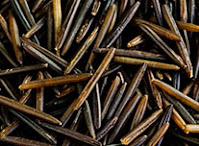Did you know that there are 40,000 different varieties of rice? Each type of rice has its own taste, texture and properties, that make it work well with different cooking applications.

ANATOMY OF RICE
Each grain of rice is enclosed in a tough outer hull, or husk, that needs to be removed before it can be consumed. This layer is removed in all rice types. Under the hull, the bran layer is not removed in all rice types such as brown, red, and black (forbidden) rice. The bran layer may be consumed, but it is often removed when further processing rice. Once the bran and germ layers are removed, white rice remains. Known as the endosperm, this is the part of the rice that is most commonly consumed. Found under the hull, the germ, or rice kernel, is nutrient-dense. Full of B vitamins, minerals, and proteins, it helps give rice its color and added nutritional benefits.
All rice contains 2 types of starch: amylopectin and amylose. Depending on how much of one starch it has will determine if it is sticky or fluffy and separate. One quick way to know which type it contains most of will depend on the opacity of the grain. If it is translucent and kind of waxy looking , like basmati, then it is high in amylose and will stay separated and have more of a firm, dry texture when cooked. If it has more of an opaque look, like jasmin, then it is higher in amylopectin and will be sticky and soft when cooked.
Rice is often characterized as one of three varieties - long grain, medium grain, or short grain rice. These varieties refer to the length and shape of the grain. After that it is broken down by starch content, aroma and milling (or color).
Long Grain Rice - This rice has milled grains that are at least three to four times as long as they are wide. Due to its starch composition, it is separate, light and fluffy when cooked. Most Chinese and Indian rices are long grain.
Medium Grain Rice - When compared to long grain rice, medium grain rice has a shorter, wider kernel. Since the cooked grains are more moist and tender than long grain rice, the rice has a greater tendency to stick together.These rices include ones that would be used to make risotto, paella, and some Japonica rices.
Short Grain Rice - Featuring grains that are less than twice as long as they are wide, this rice is short and best for sushi. It has a sticky texture when cooked.
Sticky Rice - Also known as sweet rice or glutinous rice, sticky rice is grown mainly in Southeast and East Asia and is used in many traditional Asian dishes, desserts, and sweets. When cooked, sticky rice is especially sticky and is often ground into rice flour.
Certain rice varieties give off pleasing fragrances while being cooked. Basmati Rice -Is a type of long-grain rice that is popular among Indian cuisine and other ethnic dishes. Cooked basmati rice imparts a subtle nutty or popcorn-like flavor and aroma.
Jasmine Rice - Jasmine rice, sometimes known as Thai fragrant rice, is a type of long grain rice with a long kernel and slightly sticky texture when cooked. Use it to infuse a subtle jasmine flavor and aroma into your dishes.
Red rice, black rice, and purple rice all feature unique pigmentation in the bran. For these colorful rice varieties, the bran layer usually remains for added visual appeal and added nutritional value. Brown Rice - Any variety of rice can be sold as brown rice. This healthful rice sheds its outer husk and retains its bran and germ layers that give it a characteristic tan color. Though brown rice takes a longer to cook than white rice, the nutrient-dense layers are rich in vitamins and minerals. When cooked it has a chewy texture and a "nutty" flavor
Parboiled Rice - This “rough” rice has gone through a steam-pressure process before the hull is removed that gelatinizes the starch in the grain. This process produces a more separate grain that is light and fluffy when cooked. Converted rice is a type of parboiled rice that has been further pre-cooked, which ultimately allows you to whip up dishes of rice even faster.
Polished Rice - The term “polished” simply refers to white rice that has had its outer brown layer of bran and germ removed. Rice that has shed its bran layers can also be referred to as "milled rice."

Wild Rice - Wild rice isn't actually even rice, the grains are harvested from the genus Zizania of grasses. High in protein and very nutrient dense, wild rice adds a colorful, exotic flair to any rice dish. Serve it with stir fry's, mushroom soups, or casseroles for something new. I would have to say that this is one of my favorites even though it does take a while to cook. It has such a unique flavor profile.
There is a great website out there called Think Rice that has a tons of great information on all the different rices, lots of recipes and hints on how to know the correct liquid to rice ratio, just look under the at home tab. For those that have only ever cooked instant rice or white rice this is a great place to go to help expand your rice repertoire. Aside from cooking with rice there are a few other "out of the box" ways you can use rice that are on the website.
For those of you that need gluten free this is a great staple to have in your house. You can also make your own flour for much cheaper than buying rice flour at the store. Just make sure that however you grind it, it becomes a fine powder. You can then use it just as you would other flour.











Comments
Post a Comment